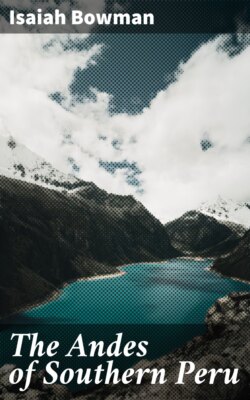Читать книгу The Andes of Southern Peru - Isaiah Bowman - Страница 10
На сайте Литреса книга снята с продажи.
The Coastal Planter
ОглавлениеThe man from the deep Majes Valley in the coastal desert rode out with me through cotton fields as rich and clean as those of a Texas plantation. He was tall, straight-limbed, and clear-eyed—one of the energetic younger generation, yet with the blood of a proud old family. We forded the river and rode on through vineyards and fig orchards loaded with fruit. His manner became deeply earnest as he pictured the future of Peru, when her people would take advantage of scientific methods and use labor-saving machinery. He said that the methods now in use were medieval, and he pointed to a score of concrete illustrations. Also, here was water running to waste, yet the desert was on either hand. There should be dams and canals. Every drop of water was needed. The population of the valley could be easily doubled.
Fig. 4—Large ground moss--so-called yareta--used for fuel. It occurs in the zone of Alpine vegetation and is best developed in regions where the snowline is highest. The photograph represents a typical occurrence between Cotahuasi and Salamanca, elevation 16,000 feet (4,880 m.). The snowline is here at 17,500 feet (5,333 m.). In the foreground is the most widely distributed tola bush, also used for fuel.
Fig. 5.—Expedition’s camp near Lamgrama, 15,500 feet (4,720 m.), after a snowstorm The location is midway in the pasture zone.
Fig. 6—Irrigated Chili Valley on the outskirts of Arequipa. The lower slopes of El Misti are in the left background. The Alto de los Huesos or Plateau of Bones lies on the farther side of the valley.
Fig. 7—Crossing the highest pass (Chuquito) in the Cordillera Vilcapampa, 14,500 feet (4,420 m.). Grazing is here carried on up to the snowline.
Capital was lacking but there was also lacking energy among the people. Slipshod methods brought them a bare living and they were too easily contented. Their standards of life should be elevated. Education was still for the few, and it should be universal. A new spirit of progress was slowly developing—a more general interest in public affairs, a desire to advance with the more progressive nations of South America—and when it had reached its culmination there would be no happier land than coastal Peru, already the seat of the densest populations and the most highly cultivated fields.
These four men have portrayed the four great regions of Peru—the lowland plains, the eastern mountain valleys, the lofty plateaus, and the valley oases of the coast. This is not all of Peru. The mountain basins have their own peculiar qualities and the valley heads of the coastal zone are unlike the lower valleys and the plateau on either hand. Yet the chief characteristics of the country are set forth with reasonable fidelity in these individual accounts. Moreover the spirit of the Peruvians is better shown thereby than their material resources. If this is not Peru, it is what the Peruvians think is Peru, and to a high degree a man’s country is what he thinks it is—at least it is little more to him.
